Mechanical Performance Evaluation of the Al-Mg-Si-(Cu) Aluminum Alloys after Transient Thermal Shock through an Novel Equivalent Structure Design and Finite Element Modeling
Abstract
1. Introduction
2. Materials and Methods
3. Results and Discussion
3.1. Temperature Distribution
3.2. Mechanical Properties
3.2.1. Hardness Variation
3.2.2. Tensile Properties and Fracture Morphology
3.3. Microstructures
3.3.1. Grain Structure Evolution
3.3.2. Precipitation Evolution
3.4. Material Constitutive Relation and Damage Model
3.5. Prediction of the Stress–Strain Response of Typical Welding Joints
4. Conclusions
- The designed method of cutting layers can obtain accurate stress–strain response of the materials in different sub-areas at different transient thermal shock temperature levels.
- The transformation of the precipitates is the key factor affecting the mechanical properties under the transient thermal shock. The transient thermal shock can be divided into over-aged zone (236.2–411.7 °C), seriously-over-aged zone (411.7–466.3 °C), and quenched zone (466.3–593.4 °C). As the temperature increases, the UTS and YS decrease gradually in over-aged and well-over-aged zones. The EL is increased in the quenched zone.
- Through refined FEM with exact material constitutive relations of sub-areas in thermally shocked structure, the force-displacement response can be simulated and predicted. With a careful determination of the GTN damage parameters, the fracture behavior can also be well predicted using the supposed FEM model building method.
Author Contributions
Funding
Conflicts of Interest
References
- Jo, H.; Cho, H.; Lee, K.; Kim, Y. Extrudability improvement and energy consumption estimation in Al extrusion process of a 7003 alloy. J. Mater. Process. Technol. 2002, 130, 407–410. [Google Scholar] [CrossRef]
- Xu, C.; He, H.; Yu, W.; Li, L. Influence of quenching temperature on peak aging time and hardness of Al-Mg-Si-Cu alloys strengthened by nano-sized precipitates. Mater. Sci. Eng. A 2019, 744, 28–35. [Google Scholar] [CrossRef]
- Händel, M.; Nickel, D.; Lampke, T. Effect of different grain sizes and textures on the corrosion behaviour of aluminum alloy AA6082. Mater. Werkstofftech. 2011, 42, 606–611. [Google Scholar] [CrossRef]
- Chen, J.; Costan, E.; Van Huis, M.; Xu, Q.; Zandbergen, H. Atomic pillar-based nanoprecipitates strengthen AlMgSi alloys. Science 2006, 312, 416–419. [Google Scholar] [CrossRef]
- Jin, S.; Ngai, T.; Zhang, G.; Zhai, T.; Jia, S.; Li, L. Precipitation strengthening mechanisms during natural ageing and subsequent artificial aging in an Al-Mg-Si-Cu alloy. Mater. Sci. Eng. A 2018, 724, 53–59. [Google Scholar] [CrossRef]
- Hori, H. Effect of heat-affected zone on joint strength of welded Al–Mg–Si System. Weld. Int. 2011, 25, 737–741. [Google Scholar] [CrossRef]
- Nie, F.; Dong, H.; Chen, S.; Li, P.; Wang, L.; Zhao, Z.; Li, X.; Zhang, H. Microstructure and mechanical properties of pulse MIG welded 6061/A356 aluminum alloy dissimilar butt joints. J. Mater. Sci. Technol. 2018, 34, 551–560. [Google Scholar] [CrossRef]
- Zhang, W.; He, H.; Xu, C.; Yu, W.; Li, L. Precipitates Dissolution, Phase Transformation, and Re-precipitation-Induced Hardness Variation in 6082-T6 Alloy during MIG Welding and Subsequent Baking. JOM USL 2019, 71, 2711–2720. [Google Scholar] [CrossRef]
- Zhang, W.; He, H.; Shan, Y.; Sun, C.; Li, L. Diffusion assisted hardness recovering and related microstructural characteristics in fusion welded Al–Mg–Si alloy butt. Mater. Res. Express. 2019, 6, 066549. [Google Scholar] [CrossRef]
- ASTM E8M-04. Standard Test Methods for Tension Testing of Metallic Materials; ASTM International: West Conshohocken, PA, USA, 2016. [Google Scholar]
- Miao, W.F.; Laughlin, D.E. Precipitation hardening in aluminum alloy 6022. Scr. Mater. 1999, 40, 873–878. [Google Scholar] [CrossRef]
- Maisonnette, D.; Suery, M.; Nelias, D.; Chaudet, P.; Epicier, T. Effects of heat treatments on the microstructure and mechanical properties of a 6061 aluminium alloy. Mater. Sci. Eng. A 2011, 528, 2718–2724. [Google Scholar] [CrossRef]
- Siddiqui, R.A.; Abdullah, H.A.; Al-Belushi, K.R. Influence of aging parameters on the mechanical properties of 6063 aluminium alloy. J. Mater. Process. Technol. 2000, 102, 234–240. [Google Scholar] [CrossRef]
- Dorward, R.; Bouvier, C. A rationalization of factors affecting strength, ductility and toughness of AA6061-type Al–Mg–Si–(Cu) alloys. Mater. Sci. Eng. A 1998, 254, 33–44. [Google Scholar] [CrossRef]
- Marioara, C.; Andersen, S.; Stene, T.; Hasting, H.; Walmsley, J.; Van Helvoort, A.; Holmestad, R. The effect of Cu on precipitation in Al–Mg–Si alloys. Philos. Mag. 2007, 87, 3385–3413. [Google Scholar] [CrossRef]
- Buchanan, K.; Colas, K.; Ribis, J.; Lopez, A.; Garnier, J. Analysis of the metastable precipitates in peak-hardness aged Al-Mg-Si (-Cu) alloys with differing Si contents. Acta Mater. 2017, 132, 209–221. [Google Scholar] [CrossRef]
- Huis, M.A.V.; Chen, J.H.; Sluiter, M.H.F.; Zandbergen, H.W. Phase stability and structural features of matrix-embedded hardening precipitates in Al–Mg–Si alloys in the early stages of evolution. Acta Mater. 2007, 55, 2183–2199. [Google Scholar] [CrossRef]
- Cayron, C.; Sagalowicz, L.; Beffort, O.; Buffat, P. Structural phase transition in Al-Cu-Mg-Si alloys by transmission electron microscopy study on an Al-4 wt% Cu-1 wt% Mg-Ag alloy reinforced by SiC particles. Philos. Mag. A 1999, 79, 2833–2851. [Google Scholar] [CrossRef]
- Cayron, C.; Buffat, P. Transmission electron microscopy study of the β’phase (Al–Mg–Si alloys) and QC phase (Al–Cu–Mg–Si alloys): Ordering mechanism and crystallographic structure. Acta Mater. 2000, 48, 2639–2653. [Google Scholar] [CrossRef]
- Ding, L.; Jia, Z.; Nie, J.F.; Weng, Y.; Cao, L.; Chen, H.; Wu, X.; Liu, Q. The structural and compositional evolution of precipitates in Al-Mg-Si-Cu alloy. Acta Mater. 2018, 145, 437–450. [Google Scholar] [CrossRef]
- Deschamps, A.; Brechet, Y. Influence of predeformation and ageing of an Al–Zn–Mg alloy—II. Modeling of precipitation kinetics and yield stress. Acta Mater. 1998, 47, 293–305. [Google Scholar] [CrossRef]
- Matsuda, K.; Ikeno, S.; Uetani, Y.; Sato, T. Metastable phases in an Al-Mg-Si alloy containing copper. Metall. Mater. Trans. A 2001, 32, 1293–1299. [Google Scholar] [CrossRef]
- Aruga, Y.; Kozuka, M.; Takaki, Y.; Sato, T. Effects of natural aging after pre-aging on clustering and bake-hardening behavior in an Al–Mg–Si alloy. Scr. Mater. 2016, 116, 82–86. [Google Scholar] [CrossRef]
- Granholt, J.D.D.A. Precipitate Structure Changes during Overaging in an Al-Mg-Si Alloy. Master’s Thesis, Institutt for fysikk, Trondheim, Norway, 2012. [Google Scholar]
- Hallquist, J.O. Nonlinear Dynamic Analysis of Structures in Three Dimensions; LS-DYNA3D; Livermore Software Technology Corp.: Livermore, CA, USA, 1994. [Google Scholar]
- Gurson, A.L. Continuum theory of ductile rupture by void nucleation and growth: Part I—Yield criteria and flow rules for porous ductile media. J. Eng. Mater. Technol. 1977, 99, 2–15. [Google Scholar] [CrossRef]
- Tvergaard, V. Influence of voids on shear band instabilities under plane strain conditions. Int. J. Fract. 1981, 17, 389–407. [Google Scholar] [CrossRef]
- Tvergaard, V. Influence of void nucleation on ductile shear fracture at a free surface. J. Mech. Phys. Solids. 1982, 30, 399–425. [Google Scholar] [CrossRef]
- Faleskog, J.; Gao, X.; Shih, C.F. Cell model for nonlinear fracture analysis—I. Micromechanics calibration. Int. J. Fract. 1998, 89, 355–373. [Google Scholar] [CrossRef]
- Thuillier, S.; Le Maoût, N.; Manach, P.Y. Influence of ductile damage on the bending behaviour of aluminium alloy thin sheets. Mater. Des. 2011, 32, 2049–2057. [Google Scholar] [CrossRef]
- Brunet, M.; Mguil, S.; Klocker, H. On the determination of true stress triaxiality in sheet metals. J. Mater. Process. Technol. 2007, 184, 272–287. [Google Scholar]
- Yan, Y.; Sun, Q.; Chen, J.; Pan, H. The initiation and propagation of edge cracks of silicon steel during tandem cold rolling process based on the Gurson–Tvergaard–Needleman damage model. J. Mater. Process. Technol. 2013, 213, 598–605. [Google Scholar] [CrossRef]
- Chhibber, R.; Arora, N.; Gupta, S.; Dutta, B. Estimation of Gurson material parameters in bimetallic weldments for the nuclear reactor heat transport piping system. Proc. Inst. Mech. Eng. Part C 2008, 222, 2331–2349. [Google Scholar] [CrossRef]
- Zhang, Z.; Thaulow, C.; Ødegård, J. A complete Gurson model approach for ductile fracture. Eng. Fract. Mech. 2000, 67, 155–168. [Google Scholar] [CrossRef]
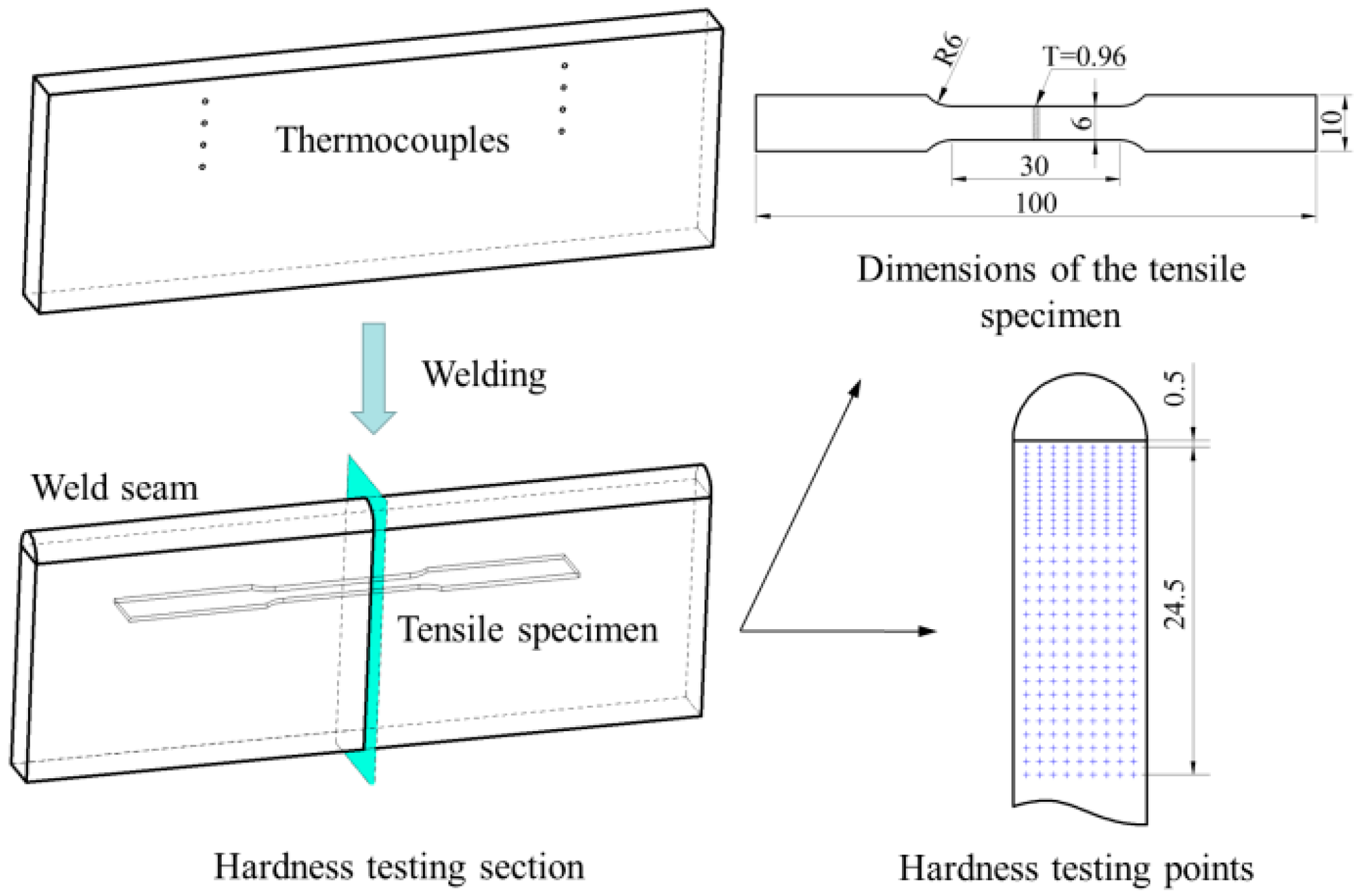

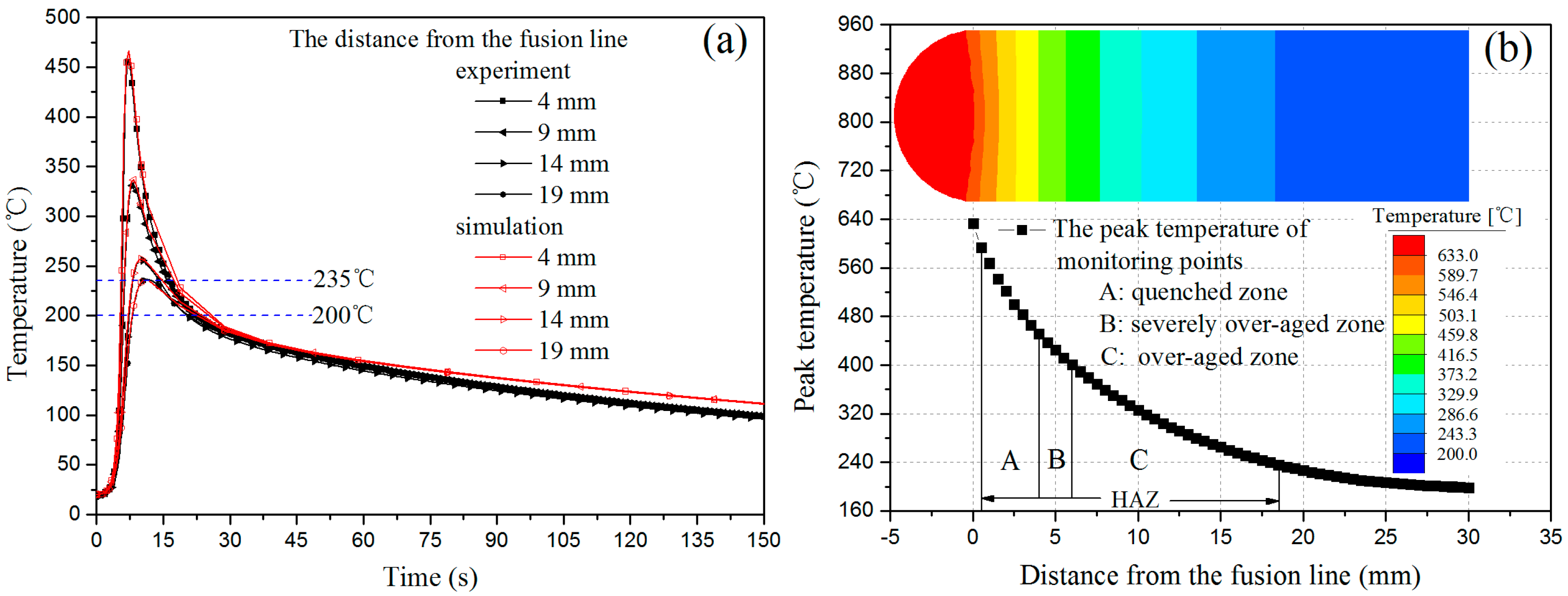
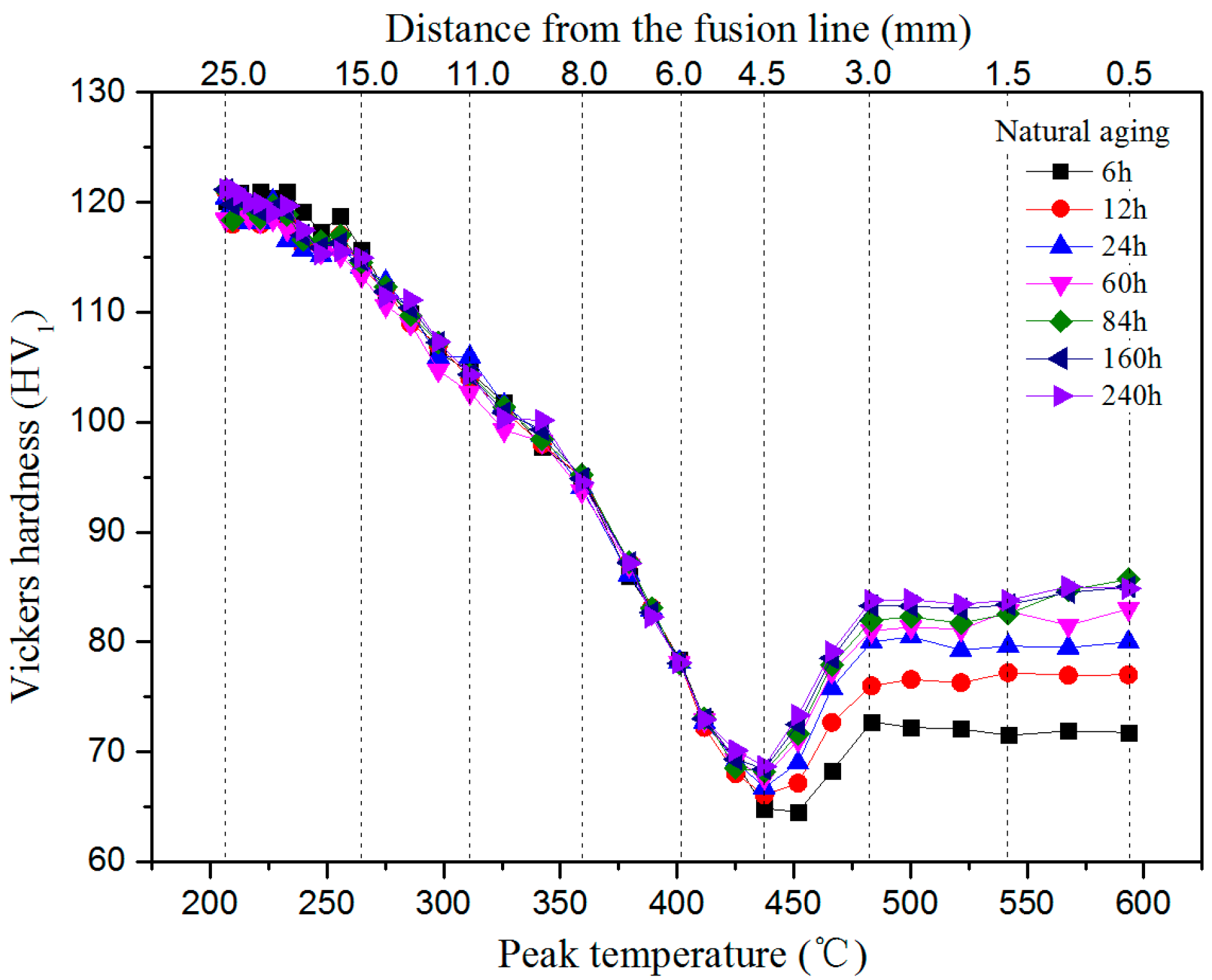
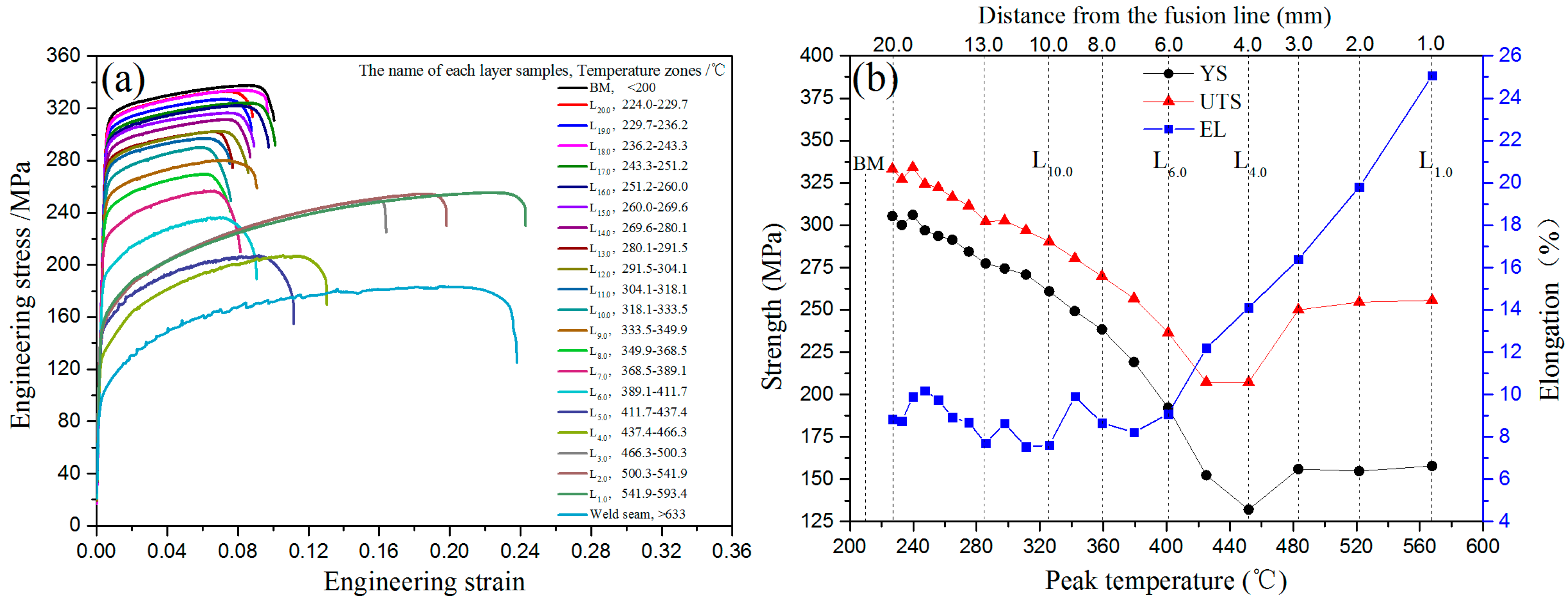
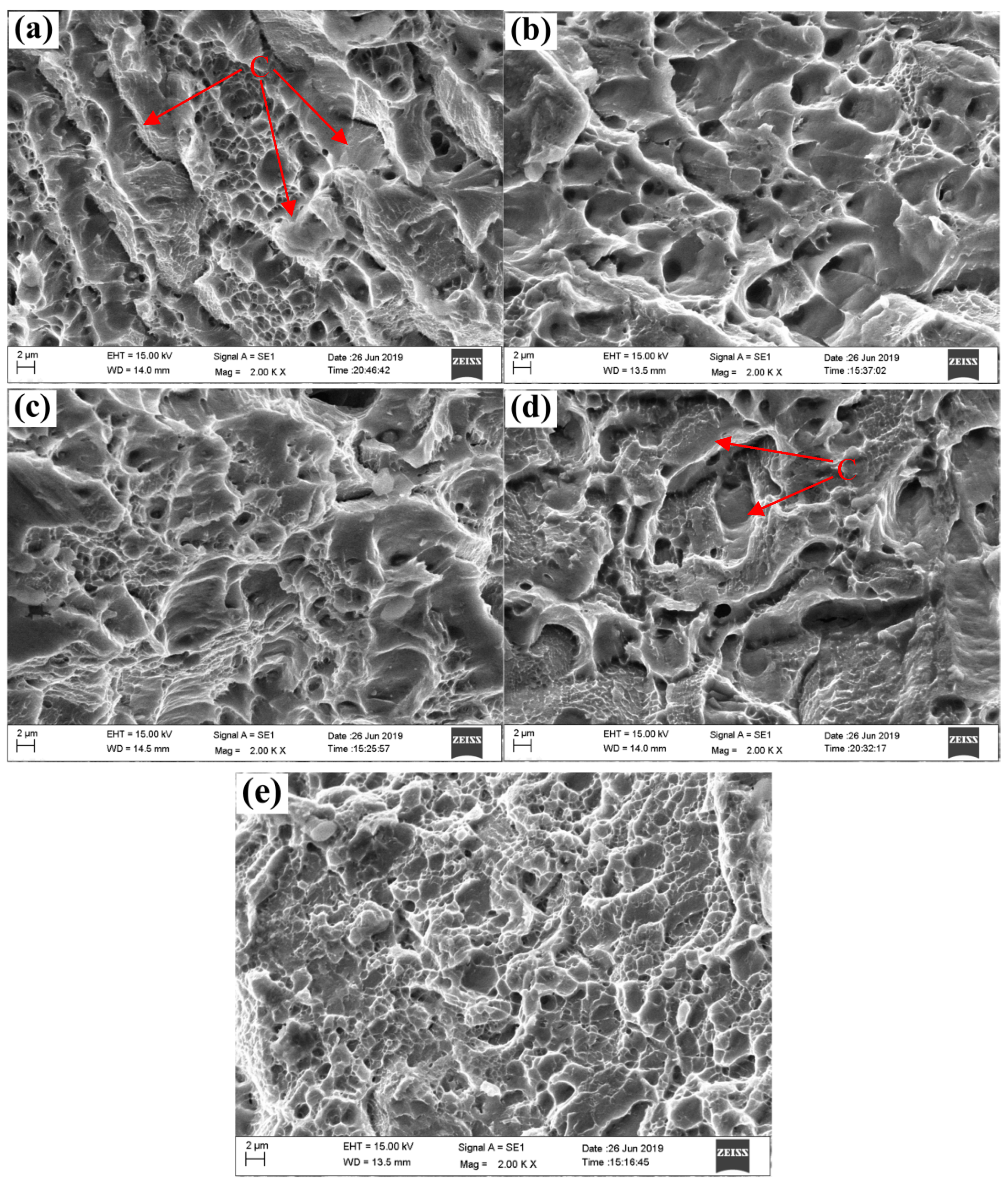

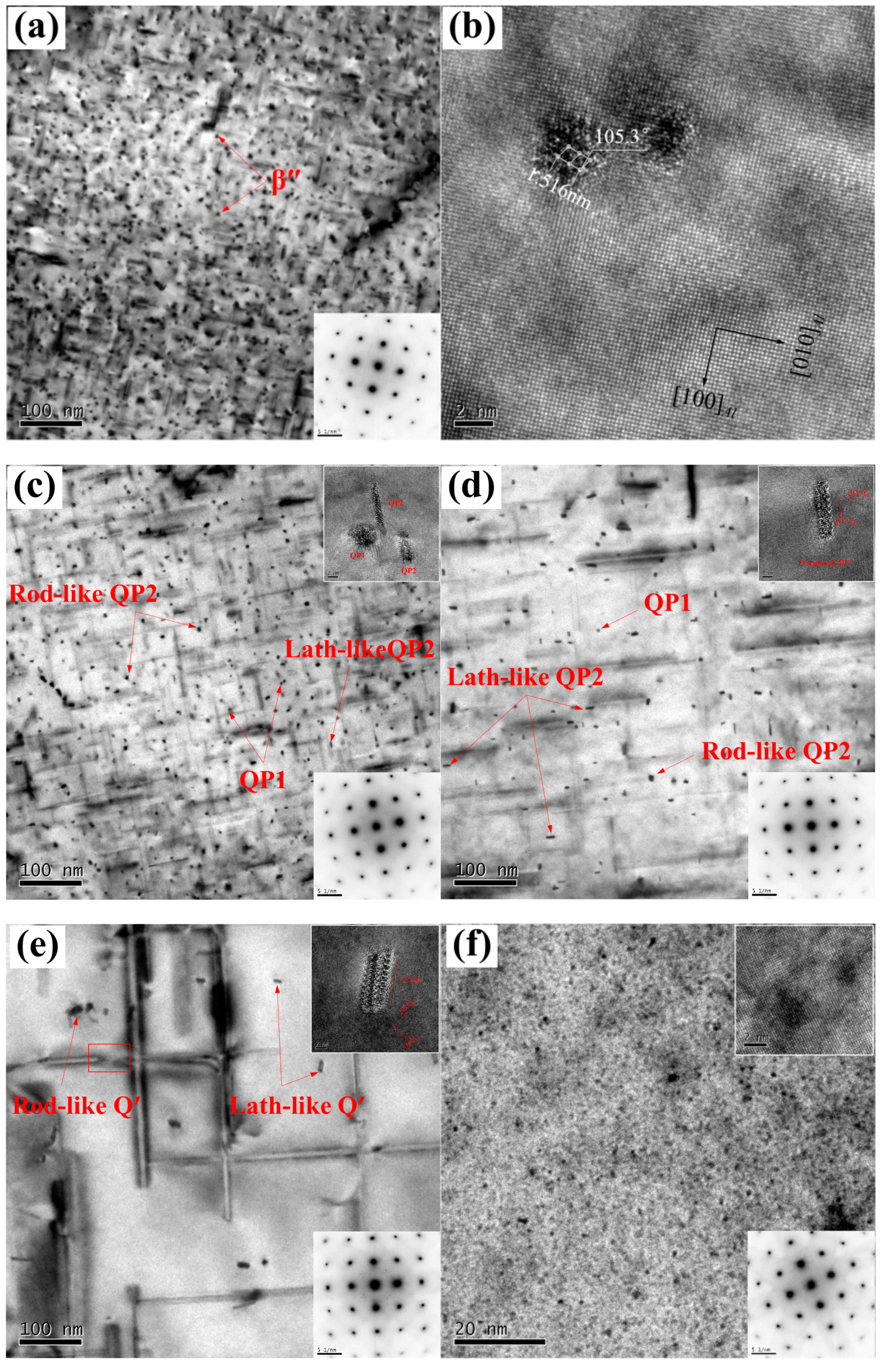
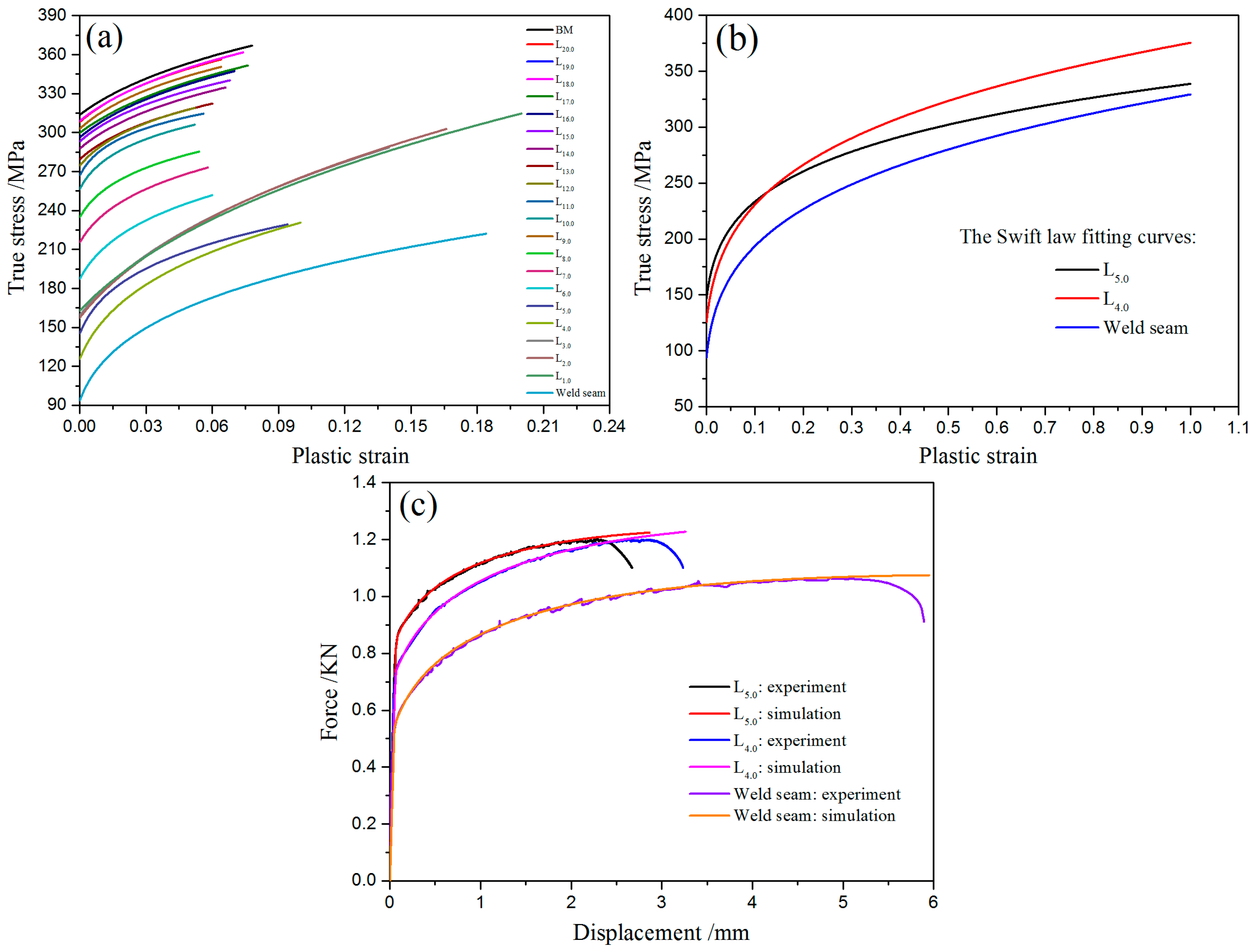
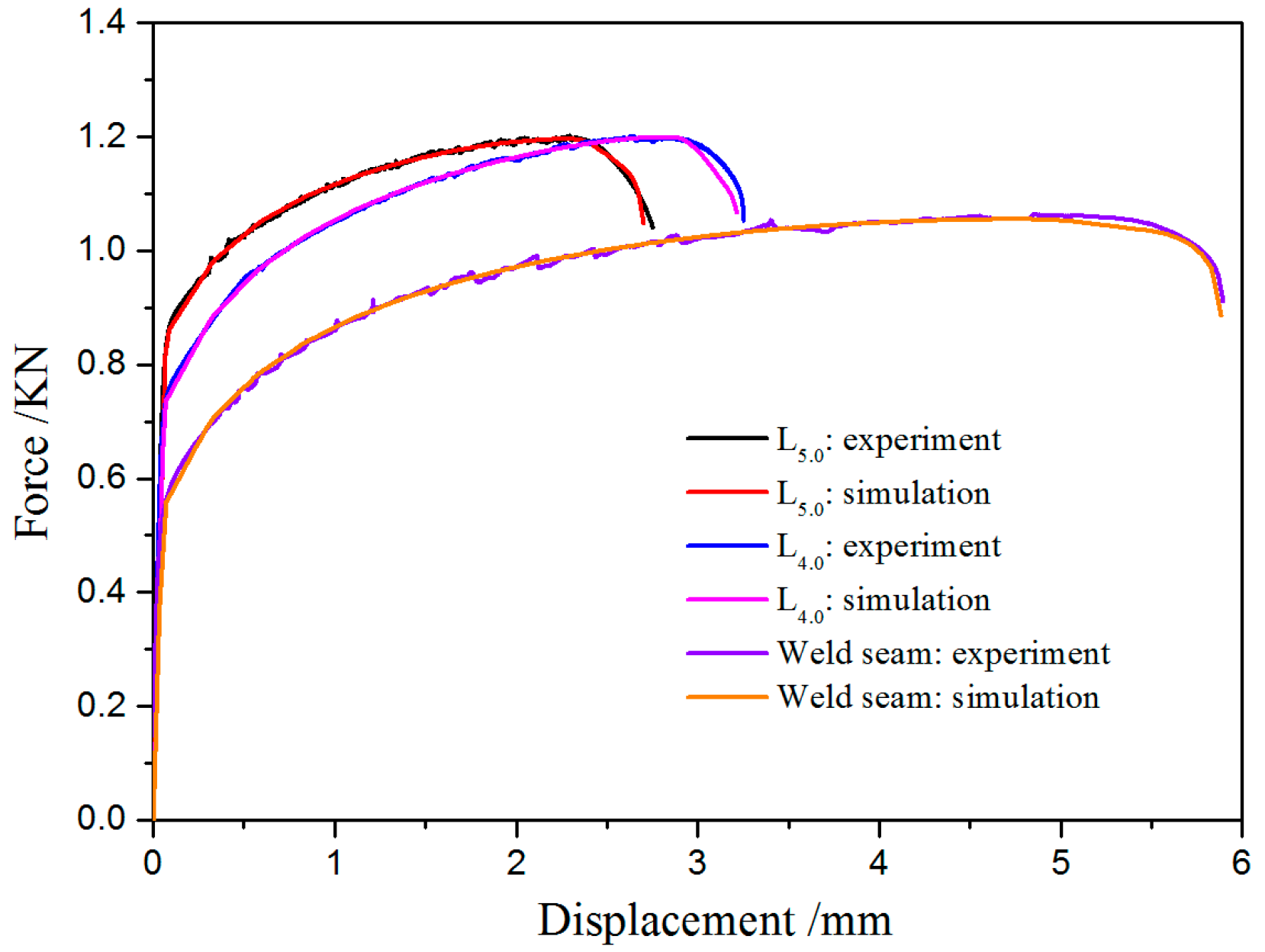

| Material | Mg | Si | Fe | Cu | Cr | Mn | Zn | Ti | Al |
|---|---|---|---|---|---|---|---|---|---|
| 6061-T6 | 0.91 | 0.64 | 0.13 | 0.36 | 0.09 | 0.07 | 0.02 | 0.02 | Bal. |
| ER5356 | data | 4.9 | 0.04 | 0.1 | 0.01 | 0.13 | 0.01 | 0.09 | Bal. |
| The Distance from the Fusion Line (mm) | Peak Temperature (°C) | Dwelling Time from Peak Temperature to 235 °C (s) | Cooling Rate (°C/s) |
|---|---|---|---|
| 4 | 465.8 | 11.01 | 20.96 |
| 9 | 335.8 | 9.16 | 11.0 |
| 14 | 256.6 | 4.68 | 4.62 |
| 19 | 235.0 | 0 | - |
| Sample Name | K/MPa | n | |
|---|---|---|---|
| L5.0 | 338.4 | 0.00662 | 0.166 |
| L4.0 | 375.0 | 0.00652 | 0.217 |
| Weld seam | 328.9 | 0.00486 | 0.235 |
| Samples Name | Temperature Range/°C | ||||||||
|---|---|---|---|---|---|---|---|---|---|
| L5.0 | 411.7–437.4 | 1.76 | 0.834 | 0 | 0.04 | 0.105 | 0.02 | 0.04 | 0.118 |
| L4.0 | 437.4–466.3 | 1.93 | 0.781 | 0 | 0.04 | 0.125 | 0.018 | 0.035 | 0.13 |
| Weld seam | >633 | 2.0 | 0.78 | 0 | 0.018 | 0.183 | 0.04 | 0.02 | 0.08 3 |
© 2020 by the authors. Licensee MDPI, Basel, Switzerland. This article is an open access article distributed under the terms and conditions of the Creative Commons Attribution (CC BY) license (http://creativecommons.org/licenses/by/4.0/).
Share and Cite
Xu, C.; Liu, K.; He, H.; Xiang, H.; Zhang, X.; Li, L. Mechanical Performance Evaluation of the Al-Mg-Si-(Cu) Aluminum Alloys after Transient Thermal Shock through an Novel Equivalent Structure Design and Finite Element Modeling. Metals 2020, 10, 537. https://doi.org/10.3390/met10040537
Xu C, Liu K, He H, Xiang H, Zhang X, Li L. Mechanical Performance Evaluation of the Al-Mg-Si-(Cu) Aluminum Alloys after Transient Thermal Shock through an Novel Equivalent Structure Design and Finite Element Modeling. Metals. 2020; 10(4):537. https://doi.org/10.3390/met10040537
Chicago/Turabian StyleXu, Congchang, Ke Liu, Hong He, Hanlin Xiang, Xinxin Zhang, and Luoxing Li. 2020. "Mechanical Performance Evaluation of the Al-Mg-Si-(Cu) Aluminum Alloys after Transient Thermal Shock through an Novel Equivalent Structure Design and Finite Element Modeling" Metals 10, no. 4: 537. https://doi.org/10.3390/met10040537
APA StyleXu, C., Liu, K., He, H., Xiang, H., Zhang, X., & Li, L. (2020). Mechanical Performance Evaluation of the Al-Mg-Si-(Cu) Aluminum Alloys after Transient Thermal Shock through an Novel Equivalent Structure Design and Finite Element Modeling. Metals, 10(4), 537. https://doi.org/10.3390/met10040537





